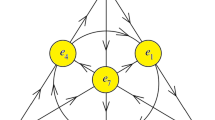Abstract
We point out a somewhat mysterious appearance of SUc(3) representations, which exhibit the behaviour of three full generations of standard model particles. These representations are found in the Clifford algebra ℂl(6), arising from the complex octonions. In this paper, we explain how this 64-complex-dimensional space comes about. With the algebra in place, we then identify generators of SU(3) within it. These SU(3) generators then act to partition the remaining part of the 64-dimensional Clifford algebra into six triplets, six singlets, and their antiparticles. That is, the algebra mirrors the chromodynamic structure of exactly three generations of the standard model’s fermions. Passing from particle to antiparticle, or vice versa, requires nothing more than effecting the complex conjugate, ∗: i ↦ − i. The entire result is achieved using only the eight-dimensional complex octonions as a single ingredient.
Article PDF
Similar content being viewed by others
Avoid common mistakes on your manuscript.
References
M. Günaydin and F. Gürsey, Quark Structure and the Octonions, J. Math. Phys. 14 (1973) 1651.
M. Günaydin and F. Gürsey, Quark Statistics and Octonions, Phys. Rev. D 9 (1974) 3387.
G. Dixon, Division Algebras: Octonions, Quaternions, Complex Numbers and the Algebraic Design of Physics, Kluwer Academic Publishers (1994).
G. Dixon, Division Algebras: Spinors: Idempotents: The Algebraic Structure of Reality, arXiv:1012.1304 [INSPIRE].
G.M. Dixon, Division Algebras: Family Replication, J. Math. Phys. 45 (2004) 3878.
A. Connes and J. Lott, Particle Models and Noncommutative Geometry, Nuc. Phys. B Proc. Suppl. 18B (1990) 29.
L. Boyle and S. Farnsworth, Non-Commutative Geometry, Non-Associative Geometry and the Standard Model of Particle Physics, arXiv:1401.5083 [INSPIRE].
A. Anastasiou, L. Borsten, M.J. Duff, L.J. Hughes and S. Nagy, An octonionic formulation of the M-theory algebra, arXiv:1402.4649 [INSPIRE].
C.A. Manogue and T. Dray, Octonions, E 6 and Particle Physics, J. Phys. Conf. Ser. 254 (2010) 012005 [arXiv:0911.2253] [INSPIRE].
C.D. Carone and A. Rastogi, An Exceptional electroweak model, Phys. Rev. D 77 (2008) 035011 [arXiv:0712.1011] [INSPIRE].
G. Cossu, M. D’Elia, A. Di Giacomo, B. Lucini and C. Pica, G 2 gauge theory at finite temperature, JHEP 10 (2007) 100 [arXiv:0709.0669] [INSPIRE].
J. Danzer, C. Gattringer and A. Maas, Chiral symmetry and spectral properties of the Dirac operator in G2 Yang-Mills Theory, JHEP 01 (2009) 024 [arXiv:0810.3973] [INSPIRE].
J. Greensite, K. Langfeld, Š. Olejník, H. Reinhardt and T. Tok, Color Screening, Casimir Scaling and Domain Structure in G 2 and SU(N) Gauge Theories, Phys. Rev. D 75 (2007) 034501 [hep-lat/0609050] [INSPIRE].
K. Holland, P. Minkowski, M. Pepe and U.J. Wiese, Exceptional confinement in G 2 gauge theory, Nucl. Phys. B 668 (2003) 207 [hep-lat/0302023] [INSPIRE].
L. Liptak and Š. Olejník, Casimir scaling in G2 lattice gauge theory, Phys. Rev. D 78 (2008) 074501 [arXiv:0807.1390] [INSPIRE].
C. Furey, Unified Theory of Ideals, Phys. Rev. D 86 (2012) 025024 [arXiv:1002.1497] [INSPIRE].
J.C. Baez, The Octonions, Bull. Am. Math. Soc. 39 (2002) 145 [math/0105155] [INSPIRE].
J.H. Conway and D.A. Smith, On Quaternions and Octonions, Their Geometry, Arithmetic, and Symmetry, Peters (2003).
S. Okubo, Introduction to Octonion and Other Non-Associative Algebras in Physics, CUP (1995).
S. De Leo and K. Abdel-Khalek, Octonionic representations of GL(8,R) and GL(4,C), J. Math. Phys. 38 (1997) 582 [hep-th/9607140] [INSPIRE].
A. Sudbery, Division Algebras, (Pseudo)orthogonal Groups and Spinors, J. Phys. A 17 (1984) 939.
Open Access
This article is distributed under the terms of the Creative Commons Attribution License (CC-BY 4.0), which permits any use, distribution and reproduction in any medium, provided the original author(s) and source are credited.
Author information
Authors and Affiliations
Corresponding author
Additional information
ArXiv ePrint: 1405.4601
Rights and permissions
Open Access This article is distributed under the terms of the Creative Commons Attribution 4.0 International License (https://creativecommons.org/licenses/by/4.0), which permits use, duplication, adaptation, distribution, and reproduction in any medium or format, as long as you give appropriate credit to the original author(s) and the source, provide a link to the Creative Commons license, and indicate if changes were made.
About this article
Cite this article
Furey, C. Generations: three prints, in colour. J. High Energ. Phys. 2014, 46 (2014). https://doi.org/10.1007/JHEP10(2014)046
Received:
Revised:
Accepted:
Published:
DOI: https://doi.org/10.1007/JHEP10(2014)046



